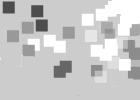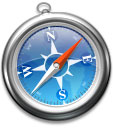In 1965 the Department of Defense Advanced
Research Project Agency (ARPA) perceived the need to develop a communication
system for the military that would function even during the devastation
of a nuclear attack. This resulted in the initial research that eventually
became the Internet. By 1969 ARPA had transmitted the first packets
of information over this new network (Leiner).
Innovations in email, browsers, search engines and networking technology
soon followed. Through the next two decades this network grew as new
technologies were developed and it quickly outgrew its original intent.
By the 1980’s the World Wide Web was being used all over the globe.
In 1990 ARPA completely abandon the Internet and left it to public
domain (Zakon).
By the end of 2005 there will be over one billion people online worldwide
(Trends and Statistics: Population Explosion).
In order to use the conduit of the
Internet as an
outlet for artistic expression we need to understand several concepts that are
inherent to the Internet.
·
The
Internet is the worlds largest network. It is a network of networks.
It is named after the Internet Protocol that all computers use to
transfer data across this network. Despite the fact that the Internet
relies on complex equipment and technologies to operate, it is simple
in overall design. It was originally planned as a simple and reliable
communication network that would function under the most adverse conditions.
Its function is to carry electric pulses from one point to another
in the most efficient way available. It does this very well.
·
Nobody
owns the Internet It is considered public domain. All the wires, routers
and other equipment that carry the data over this extensive network
belong to someone or some company. Yet the overall network, and the
right to use it, belongs to everyone (Searls).
·
Everyone
can use the Internet It is a worldwide communication pipeline that
can transmit a variety of informational and artistic mediums to points
all over the planet. It can be use for business, pleasure or any reason
we see fit.
·
Anyone
can help make it better. An army of corporations, organizations, groups
and individuals continue to make products, invent technologies, write
software and in general do a lot of work to make the Internet better
for all that choose to use it. Some do this for profit, some out of
social responsibility and some for self-satisfaction or other personal
reasons. Rich or poor, novice or techie, programmer, engineer, writer
or artist. Each person has the ability to make the Internet better
in some way.
·
Anyone can make it
worse. Hackers, viruses, money scams, identity theft , pornography, data theft
and dozens of other problems exist online. Many websites advocate various types
of hate, bigotry, violence and an entire array of ideas that most people find
repulsive and wrong.
Artists use the Internet
in many ways. Visual artists such as painters and sculptors often use
the net to show their wares to the world. Singers, songwriters, actors,
designers and authors all display their creativity online in text, video
and audio formats. Animators and filmmakers also use the web to demonstrate
their work. Artists from all corners of the earth, using every imagineable
medium display their work on the net. Every form of art available is
demonstrated on the Internet.











